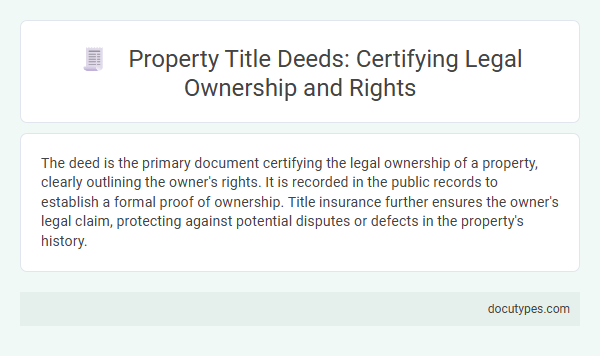The deed is the primary document certifying the legal ownership of a property, clearly outlining the owner's rights. It is recorded in the public records to establish a formal proof of ownership. Title insurance further ensures the owner's legal claim, protecting against potential disputes or defects in the property's history.
Understanding Property Title Deeds
| Document Type | Description | Key Features |
|---|---|---|
| Property Title Deed | The primary legal document certifying ownership of real estate. |
|
| Title Certificate | Issued by a government authority validating the ownership details on the deed. | Provides verification of recorded ownership status. |
| Title Insurance Policy | Protects property buyers against potential defects in the title. | Covers legal costs in case of ownership disputes. |
Importance of Title Deeds in Real Estate
The document that certifies the legal ownership of a property is known as the title deed. This essential legal paper proves the owner's rights to the real estate and outlines any claims or encumbrances.
Title deeds play a critical role in real estate transactions and property management. They provide clear evidence of ownership, ensuring that buyers can verify the legitimacy of the seller's claim. Without a proper title deed, disputes or legal challenges to ownership may arise, affecting property value and transferability.
Types of Property Title Deeds
Legal ownership of a property is certified through specific documents known as property title deeds. These deeds serve as official proof that You hold rightful ownership of real estate.
- Warranty Deed - Guarantees that the seller holds clear title to the property and has the right to sell it, providing the highest level of protection for the buyer.
- Quitclaim Deed - Transfers whatever ownership interest the grantor has in the property without any warranties, often used between family members or to clear up title issues.
- Bargain and Sale Deed - Implies the grantor holds title and possession but offers no warranties against liens or other encumbrances, commonly used in foreclosure sales or tax sales.
Key Information Included in Title Deeds
The document that certifies the legal ownership of a property is the title deed. Title deeds include key information such as the owner's name, a detailed property description, and any encumbrances or liens. Your title deed serves as the official proof of ownership and rights associated with the property.
Legal Process of Obtaining a Title Deed
The document that certifies the legal ownership of a property is known as the title deed. Obtaining a title deed involves a formal legal process that verifies the transfer and registration of property rights.
- Verification of Property Details - This step involves confirming the property's description, boundaries, and ownership history through official land records.
- Application for Title Deed - The property buyer submits an application with required documents to the land registry or relevant authority.
- Registration and Issuance - The land registry verifies the application and legally registers the new owner, issuing the title deed as proof of ownership.
How Title Deeds Prove Ownership and Rights
Title deeds serve as the primary document certifying legal ownership of a property, detailing the owner's name and the property's description. These documents provide proof of ownership rights, including the ability to sell, lease, or transfer the property. Title deeds also record any encumbrances or liens, ensuring clarity of property rights and responsibilities.
Common Issues with Title Deeds
The document that certifies the legal ownership of a property is the title deed. This essential legal record proves your right to possess and use the property.
Common issues with title deeds include errors in the owner's name, unclear boundaries, or unresolved liens. Such problems can delay sales, cause disputes, or affect the property's market value.
Title Deed Verification and Authentication
The document that certifies the legal ownership of a property is the title deed. Verifying and authenticating this deed ensures the legitimacy of your property rights.
- Title Deed Verification - Confirms the accuracy of ownership details and property description recorded in official land records.
- Authentication Process - Involves checking the deed's registration with competent government authorities to prevent fraud.
- Legal Ownership Confirmation - Validates that the deed holder possesses valid and transferable rights over the property.
Proper title deed verification and authentication are essential to safeguard your investment and avoid future disputes.
Transferring Property Through Title Deeds
The legal ownership of a property is certified by the title deed. This document serves as official proof that you hold the title to the property.
Transferring property through title deeds involves recording the deed with the relevant government authority. This process ensures the new owner's name is legally recognized and protects ownership rights.
What Document Certifies the Legal Ownership of a Property? Infographic

